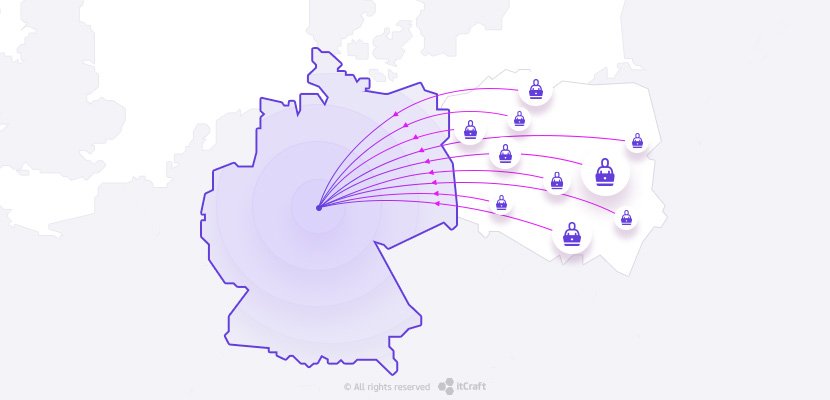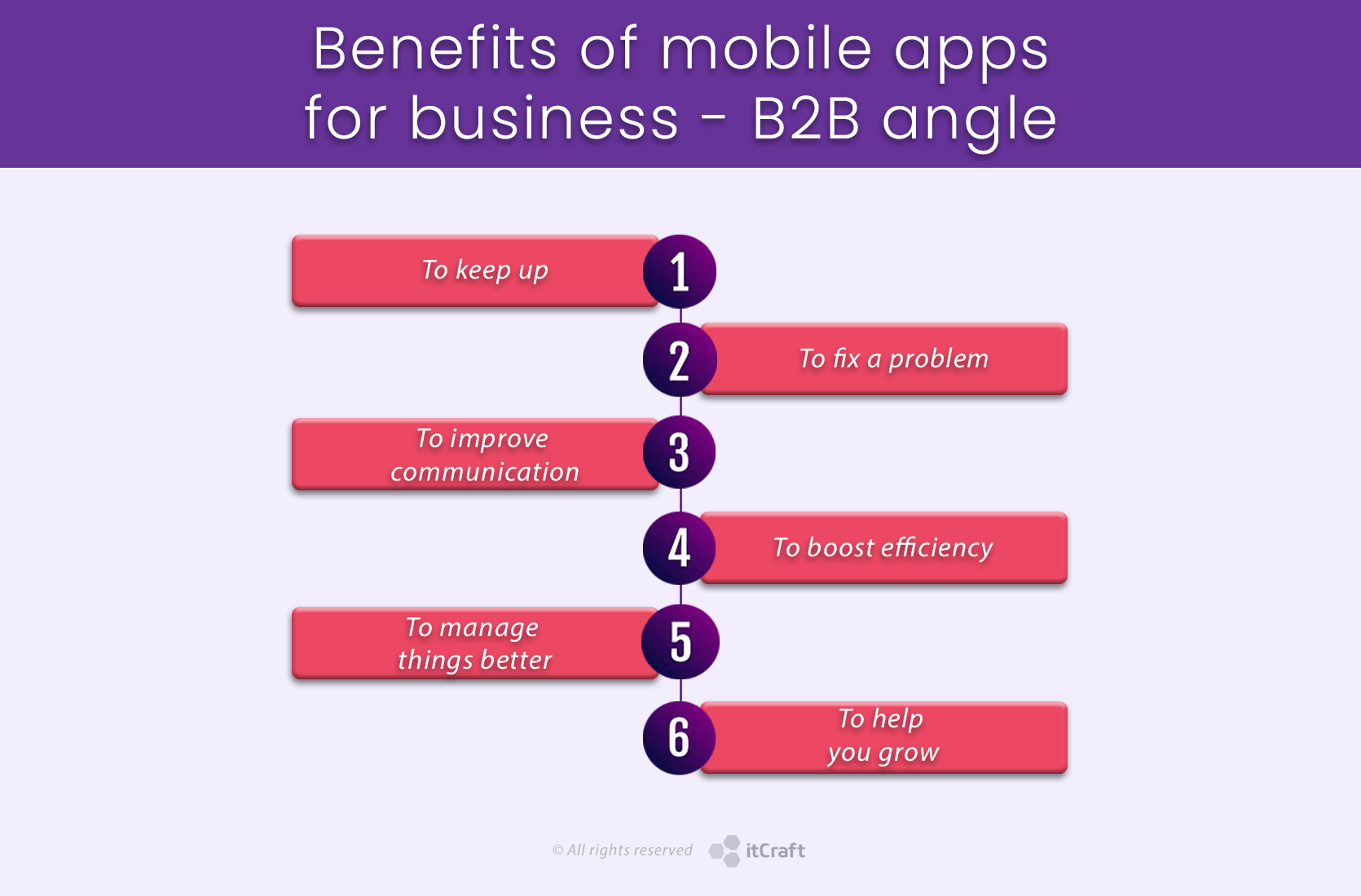Agile software development

Paweł

Alexa Trachim

Krzysztof Derech
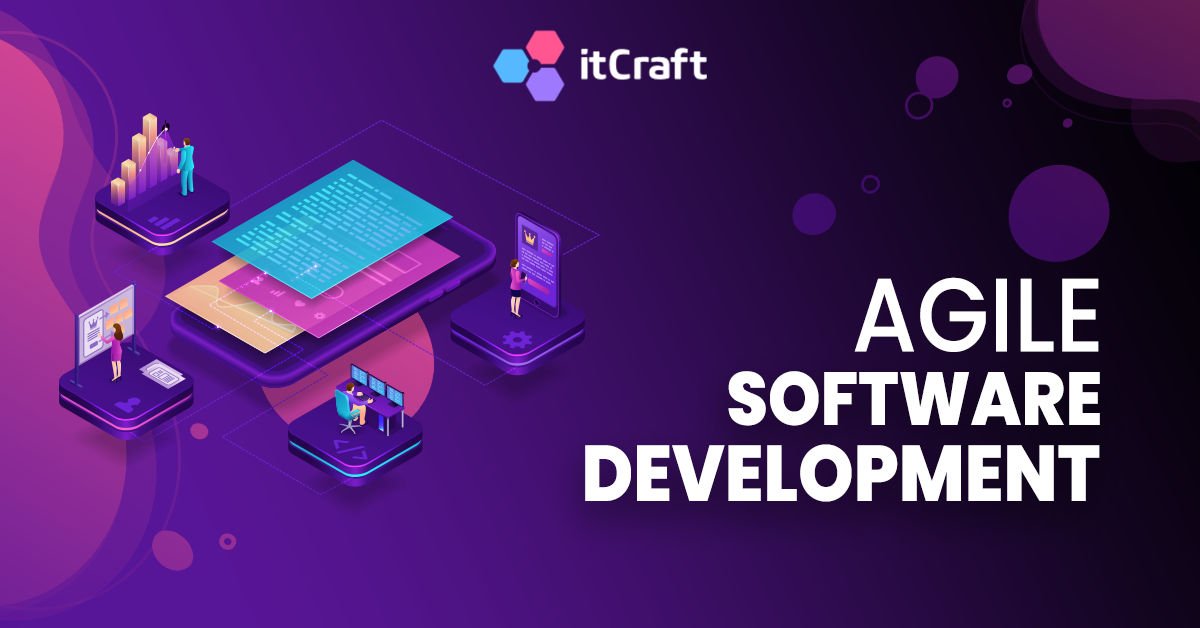
Agile is the word you will hear from software developers from around the globe. Everyone claims stuff like “We’re doing agile” “We work totally in agile” “Agile is our priority”.
Table of contenets
- What is Agile?
– Roles in Agile software development
– Agile Manifesto & 12 principles - What is Scrum?
– Scrum Roles - The principles of Scrum
– Sprints
– Meetings
– User stories - Agile project management
– Setting goals and iterating
– Responding to change Agile-style
– The role of the project manager
– Collaboration in Agile software development
– Mutual understanding
– Software development process
– Agile development values - Benefits of Agile
– The client
– Teams
– Scrum Master
– Third-party stakeholders - Should I use Agile in my upcoming software development project?
– Is Agile only suitable for software development? - Hire an Agile software development company
First of all, let me explain one thing: Agile is not a noun. Sorry to state the obvious, but adjectives play a rather important role in the language and “agile”, especially when it comes to software development, is a rather important word.
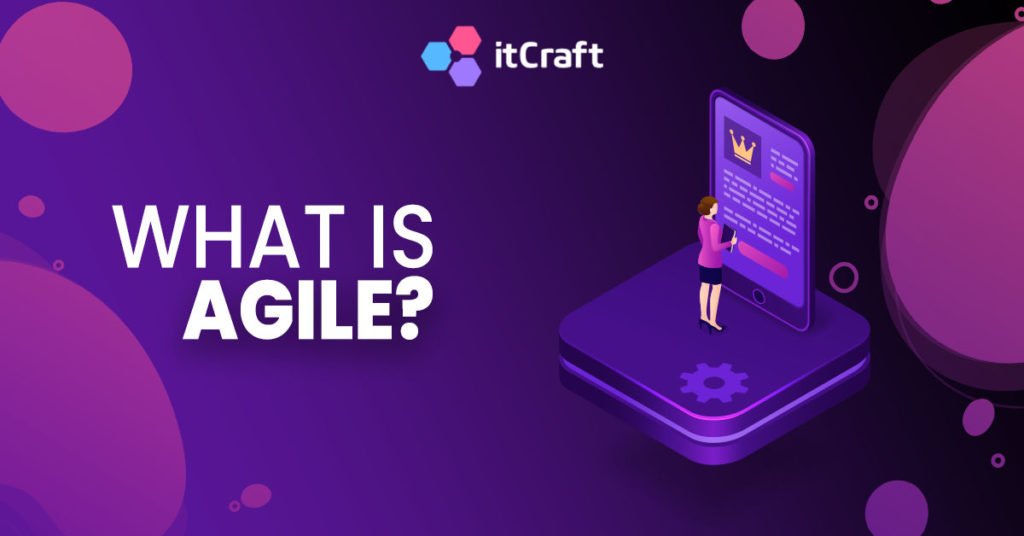
What is Agile?
In its most general sense, agile represents the approach to changing requirements. It’s the ability to adapt to a constantly evolving environment and respond to it with understanding and composure. Introducing such an attitude towards daily tasks helps every employee “keep calm and carry on” even when stressful situations occur or fiercely interrupt their workflow.
For software development to become an agile process, certain conditions must be met. The process’s priorities change from rigid into flexible and collaborative with the help of thoroughly defined roles and concrete requirements. Continuous delivery is achieved by organizing work into short cycles called sprints. Self-organizing and cross-functional teams are the key to success when running an Agile software development process.
Agility requires that all those involved in the process collaborate on a more or less equal level, with continuous interaction and communication being the cornerstone of a successful project – see also the role of SPoC in Scrum Rules.
There are many frameworks within Agile methodology that are used by established software houses. Mostly they are: Scrum, Kanban and Extreme Programming (XP).
Roles in Agile software development
An agile process can adopt various frameworks for its needs, but the choice must be made among methodologies that are inclusive of persons involved. For the needs of any development project, we assume that the main roles to fill are:
- Product owner,
- Project manager,
- A dedicated team of developers.
A product owner has a vital role of active participation in the project. Setting requirements and propositions, managing resources, communicating them to all other parties – this is essential to give the team the idea of what should be done and how, as well as what effects are expected. Everything communicated by a product owner is then followed by an open discussion to determine possibilities, projected issues and proposed solutions.
A project manager is responsible for regular contact between the product owner and the rest of the hired team. This person organizes meetings, updates both sides with crucial information and overlooks the work to make sure everything is on the right track. Every established software house offers a dedicated project manager to their clients.
Developers are obviously responsible for delivering the final outcome. Depending on the technology, you might get one team of programmers that will build the app for many systems (cross-platform) or separate teams for Android and iOS (native development).
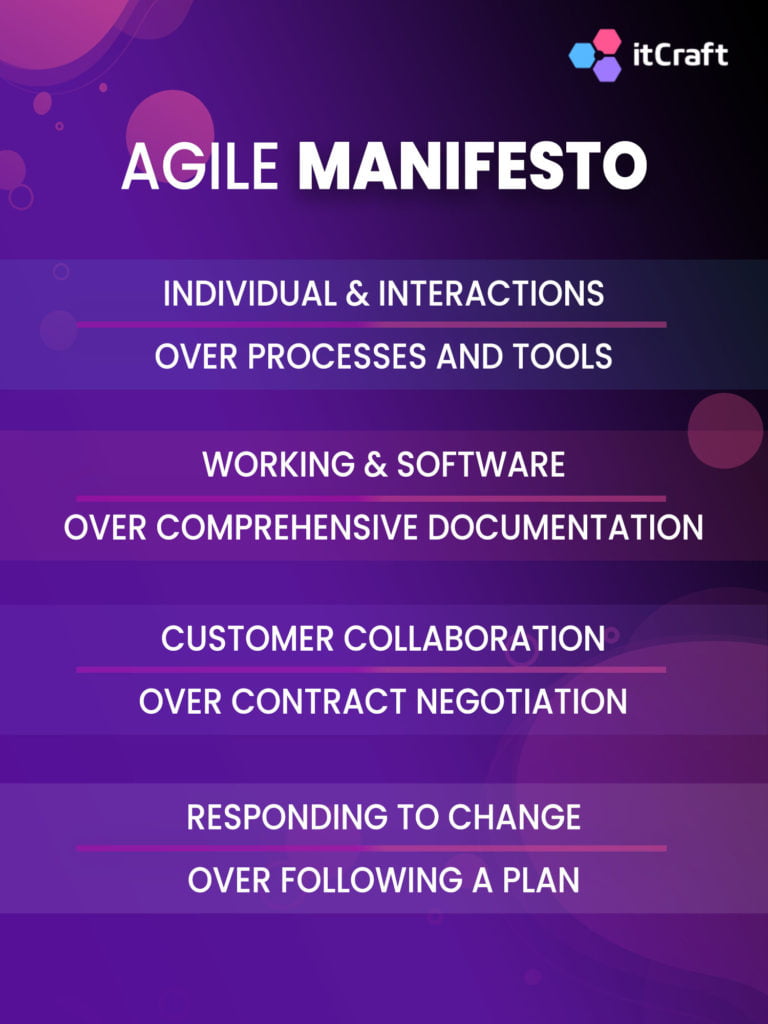
Agile Manifesto & 12 principles
There are two main acts that are the guidebook to Agile software development. That’s the Agile Manifesto and 12 principles. Reading them will give you a basic idea of what Agile actually is and the priorities it underlines. Here are the main assumptions of the Manifesto:
- Individuals and interactions over processes and tools
- Working software over comprehensive documentation
- Customer collaboration over contract negotiation
- Responding to change over following a plan
Check out our article about Agile Manifesto Principles, where we analyze these rules and explain what they mean.
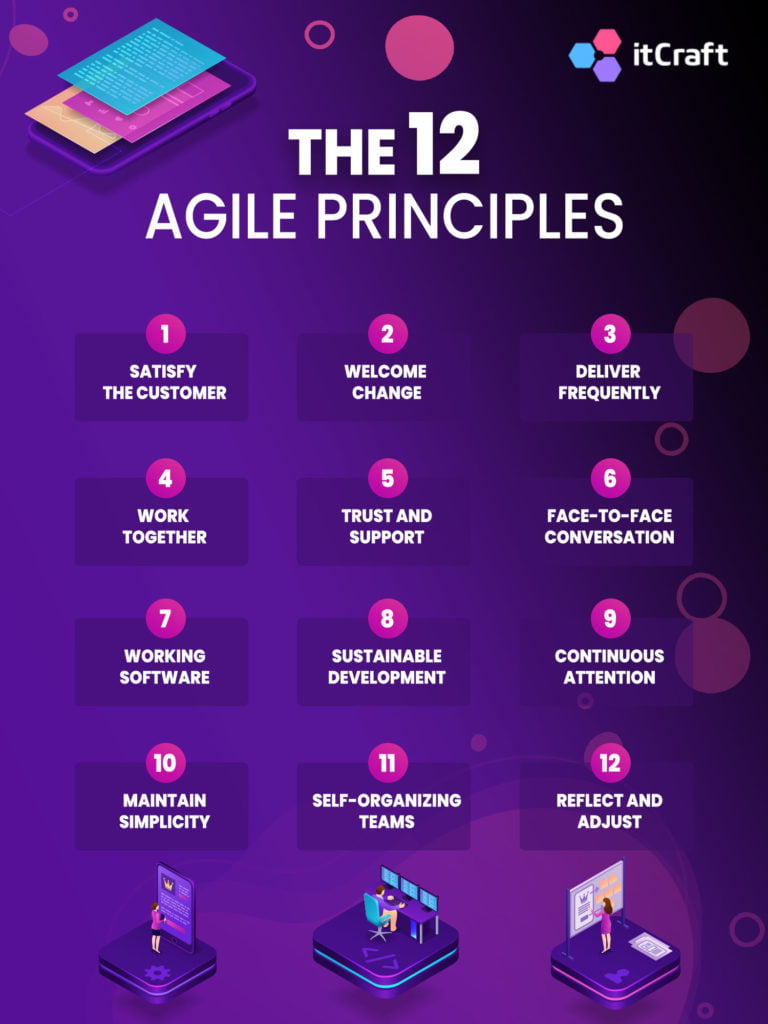
As for 12 principles, they are a more detailed and insightful amplification of the Manifesto and give the reader a basic idea of incorporating Agile into software development and business in general.
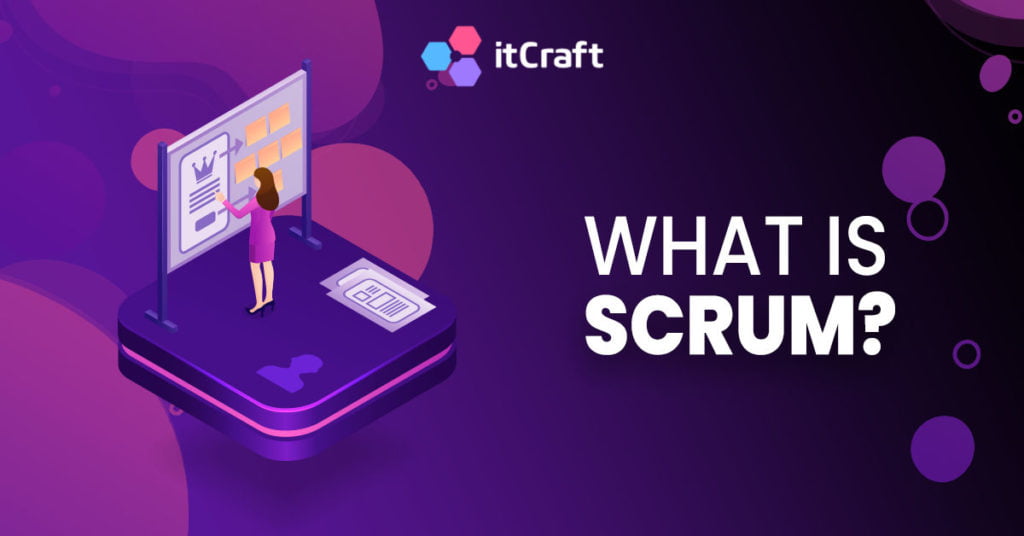
What is Scrum?
Many frameworks can be used within Agile methodologies – the examples are Scrum, Kanban, XP (Extreme Programming) and more. The first one definitely became one of the most utilized approaches in Agile software development. But what does following an agile framework actually mean?
Scrum is a set of guidelines that need to be followed to keep the production process consistent and productive. The tasks are organized in a specific way and every team member needs to follow the rules to deliver expected effects. Scrum is claimed to be a “lightweight” framework, which means it shortens side-tasks as much as possible to keep the team productive. The software development process is cut into small chunks called “sprints” – these cycles allow everyone involved to be always informed about the project’s current state.
Scrum Roles
You might probably guess that roles in Scrum are similar to those in an Agile project. For example, a product owner is always there, as it is usually the client that hires a software development team. Still, there is a particular role in Scrum that we should mention.
We are talking about a Scrum Master. This person is sometimes equated with a project manager, but it doesn’t always have to be the same team member. No matter if that’s the case or not, a Scrum Master has to know all the rules of the Agile method and Scrum framework. Their primary duty is to recognize difficulties and tackle them to make sure the team has conditions to work smoothly on the project.
Every time there is something wrong with the process, a Scrum Master analyzes the situation and implements solutions that promote productivity. They can organize meetings if the case is critical and discuss it with the team. But on a daily basis, their main task is to tweak the organization plan here and there to make sure everything is running like a well-oiled machine.
It is worth mentioning that a Scrum team is a self-organizing team, usually up to 7 people. It means that they can approach problems and obstacles within their own circle without the help of a manager – looking actively for the best ways to fix them and go right back on track. When composing Agile cross-functional teams, the most significant factor is skills (hard and soft) – members do not need to have particular roles. Still, they should complement each other with their abilities. A manager’s role in this environment is to find the right people for the project and make sure they know or can learn a needed skill.
The principles of Scrum
There are a couple of main rules in Scrum that are followed by Agile methodology teams. Let’s take a closer look to show you how they can influence their workflow and why they are essential.
Sprints
A sprint is the primary work unit in Scrum and it usually takes from one to four weeks. During that time, the team’s duty is to develop a significant part of the product. What’s crucial here is that even though there isn’t any set in stone time period for Scrum sprints, a team should determine how long every sprint in their project will be beforehand. Put merely, sprints within one Agile project should have the same length.
Meetings
When team members work together, they need to communicate. That’s what meetings (offline and online) are for. There are a couple of meeting types in Agile that help to organize work and update all involved people about progress. It all starts with Daily Scrum that happens every 24 hours and lasts for only 15 minutes. It should always be hosted at the exact same time and place.
The next essential type of meeting is Sprint Planning, which is organized before every sprint begins. This time is used to plan upcoming work and discuss how the results can be achieved efficiently. For 4-week Sprints, this meeting lasts 8 hours. And since every sprint needs a planning session, there’s also Sprint Review at the end of each cycle. It’s length is half of the time spent on planning. Obviously, this is a meeting dedicated to reviewing the current state of work and answering any issues or questions that occurred during the sprint.
Last but not least, there are Retrospective Meetings. Reflecting on previous Sprints, finding out what can be improved and what was done exceptionally well is the way to optimize all processes and achieve even better results towards the end of the project.
User stories
Inspired by Extreme Programming Agile methodology, Scrum also adopted a concept of user stories as one of the main requirements. We usually create them during UX/UI workshops at the beginning of the collaboration with our clients. This way, we can understand the business goals that are the lifeblood of the project. Then, every single functionality is written using a pattern:
As a <user>, I want <what> so that <why>.
Each user story should be prioritized, have external references if necessary and have acceptance criteria – which is more or less the point when the user achieves the goal behind the story. The story writers can also think about resource estimation and the ways of testing and implementing for particular features. Everything should be written down and put in a visible place – a whiteboard or a digital document available for everyone in the project.
We discussed this subject more in our article about user stories, where we even call it a useful tool in agile development and explain how to write them correctly.
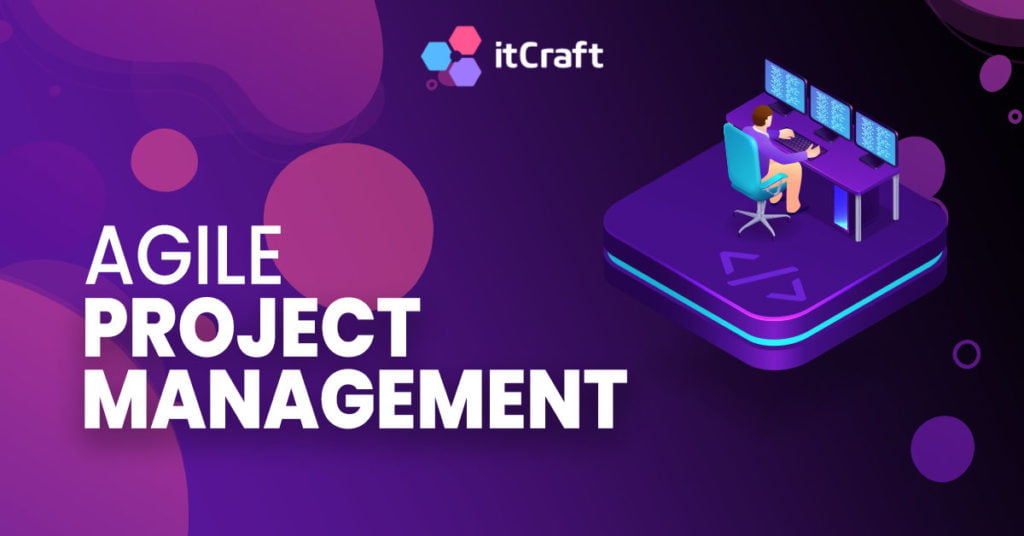
Agile project management
Now, let’s take a closer look at Agile software development and how it can be applied to processes that are an integral part of an IT company. To deliver high-quality apps, we always make sure to provide the most suitable project manager that knows the Agile principles and knows how to organize tasks to motivate team members and deliver results on time.
What is our approach to managing projects in the spirit of Agile?
Setting goals and iterating
Depending on the project’s complexity, development stages are established, with specific general goals to be achieved in each. They get more detailed at the beginning of the stage but should remain constant throughout it. The more the client is involved, the better their vision can be realized. One little detail is worth nothing here. All the changes we try to introduce during the development process require time and work to develop.
That’s why it is so essential to iterate – organize Sprints, plan strategies for the next periods and recognize parts that need to be done better. In Agile software development, we have different teams work together – design, development, quality assurance. To make sure we can achieve continuous delivery within the scope of the project, there has to be constant communication.
Responding to change Agile-style
With software, changes don’t happen overnight, and often more than one person is required to actually implement them. Adding even the smallest detail could mean many extra hours for the developers, so it’s best to stick to ideas and requirements agreed at the start of a given stage of work. Even though software development is Agile, it doesn’t mean it should be made chaotic. At the beginning of a stage, set the goals and stick to them. Trying to change stuff mid-stage is frustrating to all involved, and usually ends badly.
Still, if there’s a need for flexibility, make sure to introduce changes mindfully and keep processes and tools in place. At the beginning of the collaboration, we determine the rules that will allow the parties to change the project’s scope to some extent. We are always consistent about them and we warn the client about consequences (higher costs, longer time-to-market) when there is a need to revisit some concepts that were agreed upon beforehand.
The role of the project manager
The project manager or team leader is the relay between the client and the team. They serve as the organizers, gatherers of ideas, but they are most notably responsible for reliable communication.
The agility of the process doesn’t mean it’s a free for all situation. A project manager must decide how to approach specific issues and how to schedule tasks, so everything doesn’t descend into complete chaos of new ideas and constant changes. Adjustments are often required, but constant reinventing is both costly and frustrating for all involved.
Then, there are the people that will create an app for you. For the sake of the process, custom agile software development teams should be made according to a given project’s requirements. When those are met, they will work on all aspects of project management in a collaborative way. Suggestions for solutions may come from any team member, not necessarily the specialist in a given field. This way, a high level of collaboration is established within the software development team.
Collaboration in Agile software development
The people who are developing your project cover all critical areas of expertise. They will cooperate closely with each other and adjust their actions according to your needs. The cooperation among team members who understand and work according to agile principles will work differently to a classic team in software development. They will all contribute not only their knowledge but help each other solving problems and suggesting alternative ideas to challenging issues. The decision-making process will be collaborative, not hierarchical.
The flexibility and adaptability in the collaboration between the client, the project manager and developers are what makes the process agile. For a product owner, the ability to adjust to recommendation puts his project on the right track. The same goes for the project manager and the team, who adapt to the requirements (often changing) of the product owner and together, they find the most suitable solution to fulfill them. If anything needs clarification, all those participating in the project make themselves available and communicate regularly.
Mutual understanding
Developing software according to agile values and principles assumes that all parties involved are on the same page from the beginning. The product owner will see many questions coming their way – regarding software requirements, specifications, the scope of work, time requirements and many others. The team needs to know the general goals for the whole project, but specifics are established in stages at the start of each iteration.
The collaborative nature of agile production requires the client to be engaged in the process at the beginning of the project, at the start of each stage, and whenever important things happen.
Software development process
Estimations of time and costs for the agile project will initially seem quite ambiguous. This may be stressful, but gets quickly alleviated by tangible effects of work. Agile software development produces working pieces of software very quickly. We can get a couple of simple features or a logging screen up and running within the first weeks.
The further the project progresses, the more accurate estimations can be done regarding the remaining work.
After the initial weeks of intensive work, the active involvement of the client is significantly reduced. If few or no major changes are needed, the product owner is informed about the progress and shown the work effects for approval. They still attend meetings at the start/end of each iteration to approve the completed work and plan the next stage.
A few weeks before the projected completion of software development, the product should be ready for final testing, approvals and launch. Introducing changes at this stage is still possible, but this could mean delays or even adding new iterations to the project, depending on how significant the changes are. The client should be made aware of this fact.
Agile development values
Agile development is all about flexibility, collaboration and productiveness. The values of the agile approach encompass putting people and interactions over processes and tools. It is about producing working software or parts of it, rather than putting together volumes of documentation. Its collaborative spirit makes the customer part of the process, not just a signatory of a contract. Following a set and rigid plan gives a way to respond to change – flexibility that allows perfecting the product according to expectations.
Although tools, processes, plans, documentation are still required and used, the preference for agile development is to treat them as secondary. Agile development produces highly customized, bespoke products and gives all those involved great satisfaction and feeling of being part of something rather than just “doing their job”.

Benefits of Agile
Since you know now how Agile can facilitate any software development project, we can discuss why you should collaborate with IT companies that use this methodology with awareness. Every stakeholder can take advantage of the Agile approach and in the end – experience the enormous benefits that come with high-quality software products.
The client
For a company that hires a software house to deliver an app or other product, Agile is in favor. They can suggest and request particular things and thanks to Agile communication, they feel like they are heard and are a part of the process. Thanks to short iterations, they can see results faster and ensure themselves that everything is going according to the plan.
Another thing that can be significantly beneficial is the fact of adjusting the software development process to constantly changing customer requirements. The product owner can be the middleman between the app’s potential users and the people responsible for creating it.
Teams
The software development team, designers, testers – they can work productively because Agile eliminates unnecessary elements as much as possible. That is proven to increase the satisfaction of accomplished tasks. Every short cycle is reviewed so that the effects can be valued and appreciated.
The vendor – meaning the whole IT company that offers software development teams – also benefits from Agile. They can decrease the waste of resources and really bring value to the client by focusing on building the product in the most effective way.
Scrum Master
The main advantage for the project manager/Scrum Master is that they can be aware of the current progress of the project at all times. That helps them to detect potential problems early and quickly find fixes for them. Agile promotes organization and communication, so everything is in place and there is no space for chaos.
Third-party stakeholders
Thanks to Agile sprint meetings, they can be regularly informed about the state of the project and upcoming plans. The process is transparent about the results, which can be crucial for involved third parties as they want to know the investment brings effects without a need to wait until the end of the project.

Should I use Agile in my upcoming software development project?
No matter which framework you choose – Scrum, Extreme Programming, Kanban or something else – using Agile is always the right decision. You can even use the principles from two approaches and take what’s best for you from both. That is called a hybrid Agile methodology.
When picking a framework, you should take a closer look at your organization and the software development company you will collaborate with. Also, think about the details of your project. What are the biggest risks regarding the strategy you planned? Is your product complicated and rich in advanced features? Or maybe you care about a short time-to-market? Answering these questions will help you determine the risks and chances you should address with the right workflow methodology.
The details of your company also matter – Agile can be a great project management tool for any startup or enterprise, but you need to adjust it to the size, structure and style of working.
Is Agile only suitable for software development?
Definitely not! Although Agile was designed by developers, it is a mindset that can be applied to any business area. It is used with success in strategizing, analysis and other activities that are crucial to promote the growth of the company and achieve established goals. The main Agile principle used in various industries is the response to changing conditions that every organization will experience sooner or later. Also, every business owner that wants to function with Agile should restructure their company hierarchy. To promote this method, they need to show their employees that they can be an essential part of every process – with self-organization and the possibility to propose solutions.

Hire an Agile software development company
At itCraft, you will find teams of experts in web and mobile app development that know various native and cross-platform technologies. Of course, we use Agile Scrum with all of our clients, although we always offer an individual approach to meet the exact needs of the company we collaborate with.
We can become your reliable business partner that will always be open to your suggestions and transparent about all the stages of production. Just contact us and describe your idea in detail. We can transform it into an integral part of your business growth strategy.

